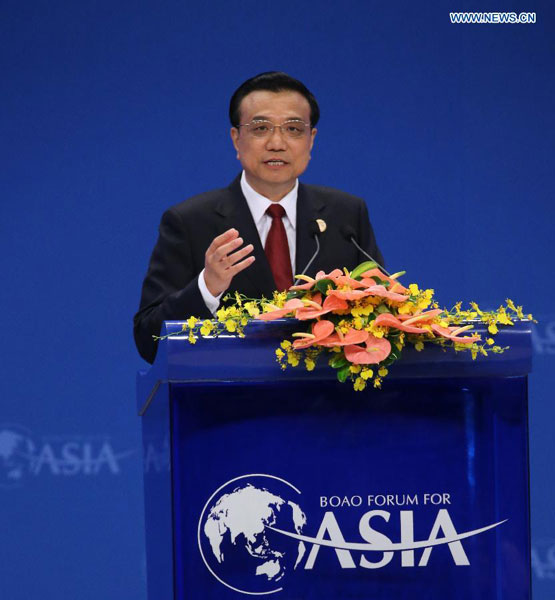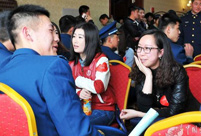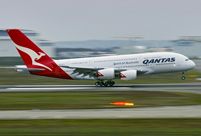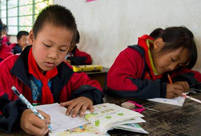 'Model husband' shatters image of love
'Model husband' shatters image of love
 Can animals smile? Or put on a happy face
Can animals smile? Or put on a happy face
 Geng Xuan crowned at 9th China Super Model Contest
Geng Xuan crowned at 9th China Super Model Contest
 Top 10 billionaires in the liquor industry
Top 10 billionaires in the liquor industry
 Backstage at China Fashion Week
Backstage at China Fashion Week
 Ballerinas anywhere but onstage
Ballerinas anywhere but onstage
 Top 10 safest airlines in the world
Top 10 safest airlines in the world
 Posters of 33rd HK Film Awards unveiled
Posters of 33rd HK Film Awards unveiled
 Top 10 most popular instant messaging apps in the world
Top 10 most popular instant messaging apps in the world
 Inspiring shadow images of Chinese army
Inspiring shadow images of Chinese army
BOAO, Hainan, April 10 -- Chinese Premier Li Keqiang delivered a keynote speech at the opening plenary of the Boao Forum for Asia Annual Conference 2014 Thursday in Boao, south China's Hainan Province.
Chinese Premier Li Keqiang delivers a keynote speech at the opening of the Boao Forum for Asia (BFA) Annual Conference 2014 in Boao, south China's Hainan Province, April 10, 2014. (Xinhua/Ding Lin)
The following is the translated version of the full text of his speech:
Jointly Open up New Vistas for Asia's Development
Speech by H.E. Li Keqiang
Premier of the State Council of the People's Republic of China
At the Opening Plenary of the Boao Forum for Asia Annual Conference 2014
Boao, April 10, 2014
Dear Guests,
Ladies and Gentlemen,
Dear Friends,
In the lovely spring, I am delighted to meet with friends from 52 countries and regions at the Boao Forum for Asia Annual Conference 2014 in the beautiful island of Hainan. On behalf of the Chinese government, I wish to extend warm congratulations on the opening of the annual conference and a hearty welcome to all forum participants.
The Boao Forum for Asia has entered its 12th year, and it has become an important platform with an Asian focus and a global vision. "Boao", the site of the Forum, means "enchanting water and abundant fish" in Chinese, and I think it is a symbol of the Forum's fruitful achievements. Attending this year's annual conference are many heads of government from Asia and Africa, and a great number of business leaders, and think tank and media representatives. Friends, both old and new, are meeting here to discuss ways to boost development of both Asia and the world. Exchange of views will create new vision, and more interactions bring friends closer. I hope that you will be fully engaged in forum discussions, and I look forward to benefiting from your insights.
Our world today is undergoing profound changes. The international architecture faces new adjustment. Uncertainties and destabilizing factors affecting the global and regional environment are increasing. Hotspot issues emerge from time to time. The world is moving towards multi-polarity amidst twists and turns. The global economy is in profound adjustment. Developed economies have seen new changes, while emerging economies have encountered new challenges, and many countries are on different economic trajectories. The global recovery has been a slow and difficult process and growth remains lackluster. To achieve strong, sustainable and balanced growth is still a daunting challenge facing all of us.
Asia is at a crucial stage of development. Asia is one of the most dynamic regions in the world. It boasts one third of the global GDP, over 4 billion people and ample supply of labor force. It enjoys distinct advantages as a late comer and has tremendous untapped development potential. That said, most Asian countries are developing nations, with low per capita GDP and uneven regional development. Over 700 million people in Asia still live below the international poverty line. Asia is faced with the huge challenge of growing the economy and improving people's livelihood. And Asian countries have to address both old problems and new ones. Ultimately, the key to solving Asia's problems lies in development. It is development that will change the world and shape the future. Development therefore remains the top priority of Asian countries.
To sustain its development momentum under the new conditions, Asia needs to find a dynamic source of development to re-energize itself. The theme of the annual conference: "Asia's New Future: Identifying New Growth Drivers" cannot be more relevant and is crucial to Asia and the world. Here, I wish to share with you my views as follows:
First, we should stick to the overarching goal of common development and build an Asian community of shared interests. In the age of economic globalization, no Asian countries can achieve development in isolation from each other, still less can they pursue development as a "zero-sum game". Rather, with our interests closely entwined, we the Asian countries need to seek mutually beneficial cooperation where "one plus one can make more than two" and even produces a multiplying effect in which "two plus two makes more than four". The impact of the international financial crisis still affects us. Macro-policy adjustments made by developed countries have added uncertainty to the environment for development. Some Asian countries have experienced economic slowdown, rising inflation, and even capital flight and currency depreciation. Pessimistic views about the prospects of emerging economies have resurfaced. Faced with these new developments and new problems, we countries in Asia should continue to act in the spirit of solidarity in face of difficulties, turn our strong economic complementarity into mutual support for each other's development, expand convergence of interests and achieve mutually beneficial coexistence and win-win development.
In the past decade and more, intra-regional trade in Asia has expanded from US$1 trillion to US$3 trillion, and its share of total trade of all Asian countries increased from 30% to 50%. Yet this is still far less than that in the EU. Regional economic integration meets the interests of all Asian countries. We need to work in unison to promote trade liberalization and investment facilitation, and upgrade regional and sub-regional cooperation. The negotiation on the Regional Comprehensive Economic Partnership (RCEP) is the largest trade agreement negotiation with the most extensive participation in East Asia, and the RCEP is integration of existing mature free trade areas. Being highly inclusive and based on Asia's industrial structure, economic model and social tradition, the RCEP is a phased-in arrangement that accommodates member countries at different levels of development, and it does not exclude other regional trading arrangements. China will work with all other parties to accelerate the negotiating process. At the same time, the launching of a feasibility study on a Free Trade Area of the Asia-Pacific (FTAAP) may be considered to maximize the benefits of trade and investment in the Asia-Pacific. China takes an open position towards the Trans-Pacific Partnership (TPP). As long as the TPP is conducive to the development of global trade and the fostering of an equitable and open trading environment, China is happy to see its conclusion. We are committed to upholding the central role of the WTO multilateral trading system in global trade development. Both the RCEP and the TPP should become important supplements to the multilateral trading system, and these two mechanisms should go hand in hand and reinforce each other. We hope that agreement can be reached on the RCEP by 2015. As a Chinese saying goes, "When everybody puts firewood in the fire, the flame rises high." As long as the Asian countries make concerted efforts, we can ensure that Asia will continue to serve as an important engine driving the global economy.

 Wonderful moment of China's airborne forces
Wonderful moment of China's airborne forces Bai Baihe shoots for fashion magazine
Bai Baihe shoots for fashion magazine Red terraced fields in Dongchuan of Yunnan
Red terraced fields in Dongchuan of Yunnan Jiaju Tibetan Village
Jiaju Tibetan Village Spring dating
Spring dating Confucius institute at UC Davis
Confucius institute at UC Davis Little painted faces at temple fair
Little painted faces at temple fair Top 10 safest airlines in the world
Top 10 safest airlines in the world Foreign students at China-Myanmar border
Foreign students at China-Myanmar border The backstage of the Fashion Week
The backstage of the Fashion Week College students in Han costumes
College students in Han costumes Postgraduate works as waitress
Postgraduate works as waitress Life in a Lahu village in Yunnan
Life in a Lahu village in Yunnan An orphan’s wedding
An orphan’s wedding Hollywood documentary brings Diaoyu Islands truth to new audience
Hollywood documentary brings Diaoyu Islands truth to new audienceDay|Week|Month